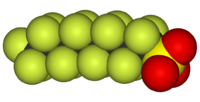
Photo from wikipedia
Abstract Taxaceae is the smallest family of conifers. Taxol is an efficient anticancer drug and widely used in the treatment of several cancers. However, the accumulation of taxoids as well… Click to show full abstract
Abstract Taxaceae is the smallest family of conifers. Taxol is an efficient anticancer drug and widely used in the treatment of several cancers. However, the accumulation of taxoids as well as other metabolites can vary hugely among Taxus species. To reveal the differential accumulation of metabolites among six Taxaceae trees, including four taxol-producing (TP) and two non-taxol producing (NTP) trees, comparative metabolomic analyses were performed in the present study. In total, 3,655 metabolites were detected in all six Taxaceae trees. For taxoids, most precursors and intermediates, and end products of the intermediates of taxol, such as 3′-N-debenzoyltaxol, 3′-N-debenzoyl-2’-deoxytaxol, taxa-4(20),11(12)-dien-5α-ol, 10-deacetyl-2-debenzoylbaccatin III, taxusin and other taxusin-like metabolites highly accumulated in the TP trees. Furthermore, great variations in the content of flavonoids between the TP and NTP trees were observed. A Liquid Chromatography-Mass Spectrometer analysis was applied to determine the contents of individual flavonoids. In detail, T. media contained the highest levels of quercetin, kaempferol, apigenin, luteolin, ginkgetin and (-)-epicatechin. For hormones, abscisate and abscisic acid highly accumulated in the NTP trees, whereas gibberellic acids substantially accumulated in the TP trees. The results can contribute to understand of the mechanisms underlying taxol biosynthesis and promote comprehensive resource utilization of the Taxaceae trees.
Journal Title: Scientia Horticulturae
Year Published: 2021
Link to full text (if available)
Share on Social Media: Sign Up to like & get
recommendations!